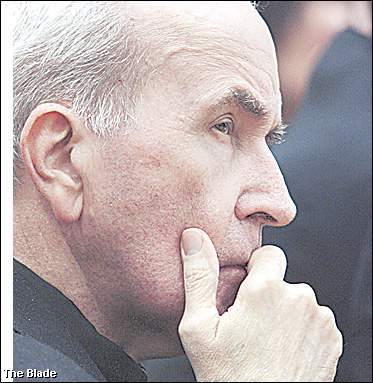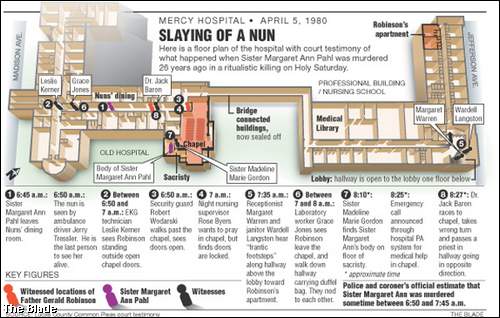By David Yonke
Toledo Blade
May 13, 2006
http://toledoblade.com/apps/pbcs.dll/article?AID=/20060513/NEWS02/605130372
The slaying of Sister Margaret Ann Pahl was "a classic textbook satanic cult killing," according to Lucas County Assistant Prosecutor Dean Mandros, but he thought it would not be a wise strategy to pursue in the murder trial of Toledo priest Gerald Robinson.
In an interview in his office yesterday, the day after Robinson was convicted of murdering Sister Margaret Ann on Holy Saturday 26 years ago, Mr. Mandros said he "did not want to go in that direction" of trying to prove that the crime was a satanic slaying.
"There was a tremendous amount of evidence that would have allowed you to make that argument," he said. "We had professionals with expertise in the occult say, 'Yes, this is a classic textbook satanic cult killing' - more than any case they'd ever seen."
 |
| Gerald Robinson |
But prosecutors felt it was better to try the 68-year-old priest on a straight murder charge. That legal strategy proved successful for prosecutors Thursday morning when a Lucas County Common Pleas Court jury convicted Robinson of murder. Judge Thomas Osowik immediately sentenced the retired priest to 15 years to life in prison, with eligibility for parole in 10 1/2 years.
Defense attorneys said they plan to appeal the verdict.
Sister Margaret Ann, 71, was killed on one of the most sacred days on the Christian calendar. She was choked nearly to death, then draped with an altar cloth, transforming her body into an "altar of sacrifice," according to a Catholic priest who testified in the trial.
The killer then stabbed her nine times over the heart in the shape of an upside-down cross, removed the altar cloth, and stabbed her 22 more times.
 |
The slaying occurred in the sacristy in front of the Holy Eucharist, which Catholics believe to be the literal body of Christ.
Mr. Mandros said that if the state had filed charges against Robinson alleging it was a satanic-cult murder, it would have increased the burden of proof on prosecutors.
"It's another legal element that would have to be in the indictment and, once you argue that that's what this was, you would have been accepting the burden of proving that beyond a reasonable doubt to those 12 people," he said. "Why would I want to give myself that additional obligation?
"I think that I could have convinced quite a number of people on the jury that that was true. But I never felt like I could convince 12 of them," he said.
Despite the satanic evidence, Mr. Mandros said he is convinced of the theory he espoused in his closing argument: that Robinson killed Sister Margaret Ann in a fit of rage. He said the anti-Christian symbols were intended to desecrate the devout nun and to "leave a message for whomever his audience was."
"However, only one person knows what it all really meant. And maybe someday he'll talk," Mr. Mandros said.
Some people wonder if a killer responsible for such a brutal murder could then go 26 years without any other run-ins with the law, but Mr. Mandros said that does not surprise him.
"I never accepted the concept that if you kill someone, then you're automatically going to continue to kill people until you get caught," he said. "If he was some sort of psychotic that was getting a thrill out of killing people, now that would be different. You might expect additional acts in the future. But I never viewed it that way."
He and Lucas County cold-case investigators yesterday downplayed the significance of items taken from Robinson's house in a search warrant served after the priest's arrest on April 23, 2004. The items, which were not introduced as evidence in the murder trial, have been getting undue publicity, according to Mr. Mandros and Tom Ross, an investigator for the prosecutor's office, and Sgt. Steve Forrester of the Toledo Police Department. Among the items were pamphlets on the occult and more than 100 funeral photos of people in coffins.
"The coffin photos were in no way relevant to the case," Mr. Mandros said. "The books on the occult, they were actually published by a Catholic organization, so that goes two ways."
While photos of deceased people in open coffins are an oddity in American culture, they are common among people of Polish heritage, such as Robinson. The Rev. Marek Ciesla, pastor of St. Adalbert and St. Hedwig Catholic churches, said that when he was growing up in Poland, such photos were found in all family albums as a way of remembering the deceased.
"We always took a picture of the person who died, fully dressed in clothes, with candles around the coffin," Father Ciesla said. "I think they do it less and less now, but when I was young it was natural, normal. It had nothing to do with the occult."
Contact David Yonke at:
dyonke@theblade.com
or 419-724-6154.
Any original material on these pages is copyright © BishopAccountability.org 2004. Reproduce freely with attribution.